In this session, Ajay Argawal, Managing Partner of Bain Capital Ventures, sits down with Dan Siroker, Founder and CEO of Optimizely, to discuss just how Optimizely was able to grow so quickly and sustainably. Dan shares his passions on clearly defining culture fit before hiring, customers acting as evangelists for your product, pricing products, and honing in on a few verticals in the beginning to gain more traction.
Check out the full transcript below!
If you want to see more sessions from 2016, we’re releasing a new one each week. Subscribe here to be notified. And be sure to grab your tickets to the 2017 Annual NOW.
TRANSCRIPT
Ajay Agarwal: How’s everyone doing today?
Awesome. You guys are in for a real treat here. We’ve got Dan Siroker, the founder and CEO of Optimizely. We’ve got a great session here coming up. By way of introduction, my name is Ajay Agarwal. I’m a partner with Bain Capital Ventures.
We’re an early stage venture fund that focuses almost exclusively on B2B software, both infrastructure as well as applications. Many people, when they hear the name Bain, they assume we’re later stage guys, but in fact, the majority of what we invest in is early stage, Series A, and Series B. We have offices out here in San Francisco, and Palo Alto, as well as the East Coast, in New York, and Boston.
It’s been great to meet many of you here over the last couple of days.
I had the pleasure of meeting Dan for the first time I think in 2012 when Optimizely was raising their seed round, and then we had the good fortune of getting formally involved as part of the A in 2013. It’s been a real pleasure to be part of this rocket ship over the last four years, excited to get into it.
Dan, maybe a good place to start is introduce yourself and perhaps tell the crowd some of the inspiration behind why you started Optimizely.
Dan Siroker: Thanks for being here and can we give the band a round of applause. They’ve been great all day.
I used to work at Google as product manager in 2007. In that year I snuck in to see Barrack Obama speak when he came there. He gave this talk about how he wanted to take what we were doing at Google with evidence, and science, and feedback, and data and bring that to the government.
Inspired me to leave my job, two weeks later I flew to Chicago and signed up as a volunteer for his campaign. That eventually turned into a job as the Director of Analytics where they tasked me with figuring out how to use data to help make better decisions, which lead to A/B testing.
At the time we used products from Adobe and from Google and we saw the power of A/B testing. We also saw the pain. It really required a developer to be part of the process. The original inspiration for starting Optimizely was try to make it easy for anybody to do A/B testing and we’ve done that.
In 2012 we became the number one most adopted website optimization platform in the world. We actually had Obama and Romney using us extensively which was great. Now we’ve grown substantially since then to do much more than just A/B testing and really help organizations use data to help make better decisions, from testing to personalization to really optimizing the experience they give to each of their customers.
Ajay: That’s great. Dan, I’m curious, when you started the company back during the Obama days or at least had the inspiration of the Obama days, how did you think about the fact that in this space, you had this giant competitor called Adobe.
You had IBM in the space. Google had a free product of some kind. As a founder, why that space? On the surface, it seems crowded. It seems like it’s already been done. What caused you to think there is an opportunity there?
Dan: For us, the key, initially, was we deeply understood the problem. In almost any software business, the ones who build the best solution are the ones who deeply understand the problem. Having been the practitioner in the Obama campaign in 2008, I saw firsthand all of the ways that I would do things differently if I were a vendor trying to enable us to do testing.
That approach and that perspective was invaluable. That helped us really focus in on what to do and more importantly, what not to do in the early days. We didn’t have features that people assumed were must-haves.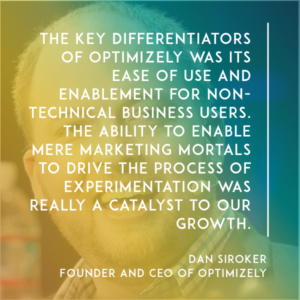
Things like multi vari testing, we didn’t have that for a year and a half, but people found that the key differentiator of ease of use and enabling non-technical business users really resonated. The ability to enable mere marketing mortals to drive the process of experimentation was really a catalyst to our growth.
With respect to Adobe, when we saw they had a product in the market that emerged from an acquisition to an acquisition, was originally Offermatica, then turned into Omniture, and eventually into the Adobe Marketing Cloud. They were great at sales and marketing. We said, “All right. Let them be great at that. We’re going to be great at the product.”
We took a differentiated approach. Then now, over time, it hollowed them out from within where the product is actually the thing that helps us win.
Ajay: I’m curious as you thought about differentiating on product. You mentioned the fact that Adobe’s great at sales and marketing. I think my understanding of their product back then was huge teams of IT required it, customized it, to implement it, to run the test. How did you think about designing this in a way that was truly democratic?
One of the hallmarks of Optimizely is the fact that a marketer, who is not technical, can start using the product. When did you figure out that that was the real insight behind getting this business off the ground?
Dan: The opportunity was always there. We did not invent A/B testing. A/B testing is a good idea. We just made it easy for anybody to do. That catalyst of the enablement of the marketer, I think, is what really helped. Adobe has a product that has been evolved through acquisitions, which turns what they’re offering into what our customers tend to describe as a Franken suite. It’s a bunch of products that don’t really integrate well with one another.
For our customers, who even these large enterprises, what they want are products that just work. They want something that abstracts complexity from the business. It’s easy. The ability to enable that practitioner and then grow from there within the entire team, I think, it’s what’s helping us win.
Ajay: You guys have actual marketers using the product every day. No IT involvement. They’re making changes. They’re running tests and they’re going ahead in implementing those tests into production?
Dan: Absolutely, yeah. A great example is IBM. They’re one of our best customers. What’s exciting for IBM, it’s a company that’s been around for over a hundred years. They have done amazing things in transforming their business every decade.
Today, they’ve really embraced this idea that in order for them to be successful in the B2B world, they need to enable their customers from a marketing perspective to interact much sooner than the sales process.
They’ve seen 70 percent of the decision gets made before sales person is involved. They use Optimizely. You’ve got a team of hundreds of people doing A/B testing optimization every single day that don’t require developers to be involved in the process.
Ajay: Very cool. Now one of the interesting things about Optimizely, Dan raised the series A when you were already $10 million run rate. He went from $1 million to $10 million on almost no capital. We’re entering in an environment where funding is potentially going to be harder to get. How did you get to that kind of scale, one, so quickly and also with so little capital?
Dan: Looking back at it we had a lot of benefits that enabled us to get tremendous leverage in the business early on. The key to focusing on the product, and making a product that people wanted to talk about and share with their colleagues, and the fact that marketers tend to talk to other marketers about best of breeds solutions, meant that we had this tremendous growth through evangelism.
Earlier today, the Box panel, they talked about how important it was to turn your best customers into evangelists. That’s a very cost effective way to get word of mouth marketing and grow. I’ll say honestly, some of our biggest weaknesses early on became some of our biggest strengths. We were not great at marketing early on.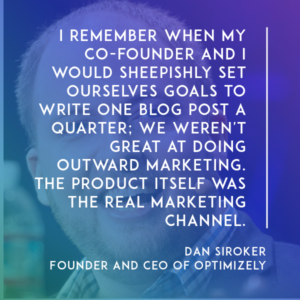
I remember my co-founder and I, we would sheepishly set ourselves goals to write one blog post a quarter. A year later – this may resonate with some folks – a year later we look at our blog and realize it’s been a year since we posted a blog post.
We weren’t great at doing that outward marketing. The product had to be the real marketing channel. That’s what helped us grow in those early days. Now that’s catalyzed what we are unable to do today.
Ajay: Makes sense. You guys really early on cracked the code on a way for your customers to try the product before they had to spend any money, which was unheard of in the testing space. Day one, the customer came to your website and they could actually see the power of it.
The real promise of Optimizely that, “Hey, a marketer can go do this on their own,” was right there for them to see before they even purchased it. Maybe talk to the crowd about how you guys pulled that off. I think it was a really powerful way for you to acquire customers.
Dan: It fits very well with our competitive differentiation against Adobe. Our initial tagline, when we started the company, was A/B testing you’ll actually use, which was a reflection of the experience that first hand I had of using the products from Google and Adobe. Seeing so many businesses who knew that A/B testing was a good idea, they just weren’t doing it.
That philosophy is what translated into the early product experience for Optimizely, which is essentially just a home page. You type in any URL, it loads into our visual editor. If you haven’t implemented Optimizely, we would actually proxy your website and inject Optimizely into it so that you get that sort of visceral magical feeling of making a change to your website without requiring a developer.
Earlier we talked a lot about crack and the cocaine. I think that was the original drug that got people hooked and got them to become our biggest evangelists within the organization. Now the marketer says, “Look, you don’t have to worry about doing code pushes to make changes for these A/B tests.”
Empower me as the marketer to run the experiments, to run the A/B tests so that the engineers can focus on what they’re great at. I think that focus on usability and getting in without having to go through a sales process really helped.
Ajay: That’s awesome. When you went out for your A round in 2013, you and Pete saw something where you said, “OK, we’re feeling escape velocity here.” What were the signs to you that we have a break-out opportunity here and it’s time to put fuel on the tank?
Dan: Part of it was, we started to see that this wasn’t just a small business thing. Early on, I remember when we first started thinking about our pricing, we had put the precious metals up on our website, bronze, silver, gold, platinum. We thought, should we put $2,000 a month on website? No, no one is going to ever pay $2,000 a month for this.
Ajay: That’s right.
Dan: We held back from that. Then every month since then, customers have paid us more and more as they get more and more value from the product. It really validated to us that this is not just a small business thing. This is also not just a lone wolf thing. This is the whole team at large enterprises like IBM who can adopt this and really transform their business into being much more data driven.
That really told us that, well now it’s time for us to really invest in our growth, invest in the future of the business. That’s why we raised the money.
Ajay: You guys also, from early days, built the product in a way to truly be horizontal. Did you try and target some verticals or did you really try and say, “It doesn’t matter.” Anyone with a website, anyone running any kind of business on a website needs to optimize it.
That can be a commerce company or a media company, what have you, certainly other startups in your space went more vertical. Was that a conscious decision or is that just where the market took you to go horizontal?
Dan: I would say it was an unconscious decision. We didn’t do a great job of deeply understanding the vertical specific problems. We’ve changed a lot since then. If I had to give myself advice to a past version of myself, I think a lot about that and I think about optimization.
It would have actually served us better to be more narrowly focused on a set of customers and deeply empathize with their biggest problems. Not just one vertical one size, but take big meaningful verticals for us. Like B2B companies, like retail, travel, media companies and understand, what are their biggest problems?
How can we, as Optimizely, solve them in scalable ways that then generalize the broader market? That’s something we’ve embraced this year’s a real, a much more deep empathy to a set of customers. Hopefully, the solutions we built for them will be broadly applicable to the rest of the market.
Ajay: Makes sense. You raise your series A. You now had capital in the bank. You had a business. You had a machine that was working, went from 1 to 10 million dollars with almost no capital. How did you make decisions on how fast to grow? How hard to hit the accelerator? How did you know you’re in this rocket….
The fuselage is starting to shake. Maybe part of one of the rockets has disintegrated, you’re going so fast. At what point did you realize, “Shit, we’re going too fast. This rocket’s going to explode.” How hard do you push it? How did you think about some of those trails, particularly when you didn’t know what you didn’t know, you know, way back when?
Dan: Why I didn’t know what I didn’t know now. Now I know a little bit more…
[crosstalk]
Dan: I’ll try to share some of that wisdom.
Ajay: That’s right.
Dan: I don’t think we got this right from day one. I remember a day when we started to describe ourselves as a rocket ship. It always made me feel a little uncomfortable. I thought it really focused on the wrong things. It focused on growth at any cost. The truth is growth has a cost. It has a cost to your culture.
It has a cost to holding true to your values and really thinking through the right decisions as opposed to the decisions for right now. I initially was pretty hesitant to describe ourselves as rocketship. I think in the last year, I reflected on what a rocket ship can uniquely do well. We talk a lot about metaphors and symbols.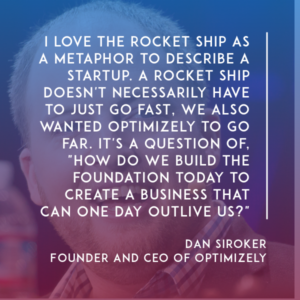
I’ll explain why I’d love actually a rocket ship as a right way to describe a startup. A rocket ship doesn’t necessarily have to just go fast. We had Optimizely. We want to go far, not just fast. We think a rocket ship is a great metaphor for that. It’s a question of, how do we build the foundation today to build the business that can hopefully one day outlive us?
That’s the kind of question we ask ourselves when we make trade offs between what’s right for maybe hitting a goal today versus what’s right for our customers in the long term. That foundation has served us really well.
I had to give myself advice early on, I would say, be really thoughtful. Make it a concious commitment not an unconscious commitment to grow at a pace that enables you to build an enduring company. Not just one of the top, fastest growing companies of the year.
Ajay: Are there examples when you look back, are there certain things or stories that you can share where you said, we did this and in hindsight it didn’t adhere to that value, or we could have grown faster but we chose not to in order to be a rocket that goes far as opposed to just fast? Any stories you can share about that?
Dan: The biggest is probably around hiring. I interviewed the first 100 people at Optimizely, and that means I also interviewed probably the other 200, 900 whatever people that we didn’t hire. I shifted in that very hands-on approach into not just delegation, but I think really abdication.
I didn’t do a great job of instilling the things that were important to me in the hiring process into my leaders. I gave them ownership and delegated that to them. It didn’t mean we necessarily hired the wrong people, but I think it made us not be as disciplined in saying, “You know maybe instead of hiring somebody, let’s try to build the system that can do this better.”
That’s an area where I think it’s easy to fall into this trap. If you raise a lot of money, it’s really easy to spend it. That’s not something that I realized at the time.
Ajay: Makes sense. Well speaking of culture, Optimizely, one of the strengths that the company’s been in the culture from day one. You have a set of values embodied by the acronym OPTIFY. Maybe share for the group your thoughts on culture and some of the things you did in the foundational years.
You always talk about how the reason you’ve been able to scale and achieve break out scale is the culture. Share your insights on that for us.
Dan: I’ll start by admitting that there are a lot of culture cynics. People think of culture as a nice to have, it’s a touchy, feely thing. I actually think it’s much more important than that. I’ll start off by just saying why did we start so early codifying our culture?
It started really with this pragmatic need to be consistent. We would interview a bunch of people on a day, and at the end of the day, the interviewers would get together and do a sync meeting. Soon I’d start to hear people say, “Oh, that person wasn’t a culture fit.” I would ask why. Their answers were always different.
I knew at least early on…and this was like 15 people. I knew early on that at least we should be consistent. We might be wrong, but at least we’re consistent on what it means to be a culture fit. That effort then transformed into really talking about the values, what are the things we care about in our co-workers, what are some things you care about in aspirational values, things we hope to achieve down the line.
We articulated that now through this processes, really this living document which is our culture document. It articulates our values as the six key values that you alluded to. Spells out OPTIFY, ownership, passion, trust, integrity, fearlessness and transparency with a Y.
I can probably speak for hours on OPTIFY, but instead of just explaining what to you those mean, I’ll just tell you a story of somebody who on their third week of the job at Optimizely really lived up to all six of these values. He’d hate that I’d told the story. His name’s Jordan. He’s a software engineer in our team.
One of the things we do at Optimizely is we have a weekly all hands. We call it Show and Tell. At this all hands, we had an update. The marketing team says everybody…we’re about 300 people at the time. The marketing says, “Hey we have this bug on the lead form. We’ve lost a couple of thousand leads.”
At the time we were getting tens of thousands of leads. We’re like, “OK, that’s too bad.” They didn’t brush it under the rug, but they admitted the low light. Then in during the Q&A session one of our team mates asked me, “Hey, so Dan I heard that we lost a couple thousand leads. What happened?”
I asked our head of engineering to come up and he said, “You know, we’ll do a full postmortem. We’ll get to the bottom of this.” Could have ended right there. Jordan, in the back of the room, raised his hand, took the microphone, which is a weird thing to do, but he’s three weeks on the job, takes the microphone, in front of the whole company says, “I was the one who introduced the bug. Here’s what went wrong. Here’s why it went wrong and here’s why things like this will never go wrong again.”
In that one moment, Jordan exemplified ownership. He owned the success or failure of what he worked on. He demonstrated passion. He had a deep authentic excitement about the work he does.
It wasn’t about being a “Rah, rah!” cheerleader passion. It was like he deeply was excited and had to own that. The amount of trust I built in him in that one moment is probably more than anything anybody else can do.
Integrity, having the willingness to be intellectually honest, fearlessness, being willing to take a risk in front of the whole company three weeks in, and transparency, really sharing, being candid about what went wrong, so we gave him close to a standing ovation for being willing to admit that.
Those are the values we care about at Optimizely.
Ajay: That’s great. You mentioned the early days where you had this culture fit. At the startup that I was with used to measure capability and culture fit, but we never codified it. It was a yes/no binary decision.
How do you guys filter, in the interview process, particularly now that you’re 400 people where it’s much harder? You’re not interviewing all 400 people or all thousand people that are interviewing for jobs. How do you guys filter for that at this stage?
Dan: Well, we had the same problem at Google. At Google, when I was interviewing there, we would interview people and have to assess them on their Googliness, but we didn’t ever define it.
Ajay: That’s right.
Dan: It was really this amorphous…Basically, do I like the person?
Ajay: Exactly.
Dan: We have a couple of ways we do it. One of the things, I have a handful of questions I like to ask to really assess their level of passion. I like to ask people, if they had 10 years to live, what would they do?
I don’t have a right or wrong answer but, if a lot about what they wanted to do if they had 10 years to live doesn’t have to do with what they’re about to do at Optimizely, I don’t think they’re deeply there for the right reasons. We try to seek missionaries not mercenaries. People who are really focused on title as part of that process, to me, is a red flag. It means that they’re about trying to make their LinkedIn profile look good, not how to make our customers wildly successful.
Those are some of the things we use.
Ajay: As you go back to the early days, are there things about the culture that, by definition, have had to change? How do you decide as a founder which of these things are not scalable and which of these are non negotiables and I’m willing to even constrain growth if I have to because, if we lose this, we lose the built-to-last foundation of the company?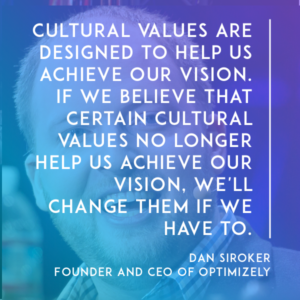
Dan: The cultural values are designed to be the ones that’ll help us achieve our vision. If we don’t believe that these cultural values are the right ones to help us achieve our vision, we’ll change our cultural values.
It’s not about a nice to have, it’s really where we’re rooted and these are the shared values that we care about. These are the ones we believe are the best ways for us to achieve success.
The values are different from the behaviors. Values of transparency, for example, are pretty universal. Behaviors within the organization, such as an early one that we had which was that, every time we’d have a meeting of two or more people at Optimizely, we would send the notes from those meetings to the whole company.
That’s a behavior that worked well at 40 people. It does not work well at 400 people. Finding ways to scale the behaviors of our culture of transparency have been things that have to change over time.
Here, now, we’re using Slack. We have much more pull, not push, communication. That’s one of the great things that I love doing is thinking about how to scale the behaviors so they still live true to our values, even though what worked for us well when were smaller might be holding us back now.
Ajay: How about symbolism? When you’re 400 people, the stories you shared, the story you just shared about Jordan, how do you get those stories out there? Do you look for opportunities to hold someone up?
Do you send a message to the whole company about something that happened in a sales call or in engineering that you want everyone to know about? How do you as a founder decide, “OK, I want to hold this example up to the whole company,” and how do you get those stories ingrained in the culture?
Dan: I see that as one of my most important solemn commitments to the company is to tell those stories, both internally and externally. We do a couple of things that facilitate that. We have this show and tell, which I actually think is one of the most powerful ways for us to adhere to a cultural value.
It’s a weekly, all hands for an hour, every Friday at 4:00 where we don’t just have me as a talking head talk about what we should be doing or not. It’s the edges of the organization who present. It’s the people, the Jordans of our company, who present. They’re the ones that tell the story.
At the end of that, I’ll nominate. You might think this is weird. We have a lot of words that we use internally. For example, we describe ourselves. If we’re a rocket ship as a company, an Optimizely employee, we’re an Optinaut. I have Optinauts of the Week where I actually tell a story for the people who’ve really lived up to our cultural values.
It’s, you know, praise is free to give. It’s a way for them to be recognized for going above and beyond. It’s always a way for us as a tribe to really recognize the people who live up to our values.
I encourage you all to really think about the ways that you can do that. A weekly all hands is a powerful way. Also, another thing I do is, for all the new employees on their first week on the job, I spend an hour with all of them talking about our culture, talking about the story, “Hey, here’s what you missed in the last six years,” and really helping them understand the stories that really live up to our cultural values.
Ajay: That’s great. Dan, I want to shift a little bit to go to market. Obviously, a lot of companies here who are scaling go to market. You’ve built an unbelievable sales machine. When we invested at the A , your payback period was three or four months.
In 2013, Dan told me a story at the end of the year that his number one performing sales person the prior year had been a Nordstrom shoe salesman. You had folks from non-traditional backgrounds come in and crushed it at Optimizely. What was it about the model in those days and today that have allowed you to create this insane machine?
I know a lot of it starts with Travis who was there in the early days and helped built that, but how did you make that happen?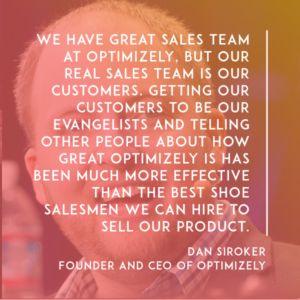
Dan: I’ll tell you a couple of secrets. One, we have great sales team at Optimizely, but our real sales team is our customers. Getting our customers to be our evangelists and telling other people about how great Optimizely is has been much more effective than the best shoe salesmen we can hire to sell our product.
The second is really I want to agree with Keith Rabois from earlier. He talked about hiring people who might not be proven. It doesn’t mean that they’re not great, but they’re at a point in their career where they haven’t demonstrated the success to get to where they ultimately will in their career.
This sales person, Julio on our team, is one of those people. He, at that time, hadn’t graduated from college. He joined as an intern. He had this tremendous raw capacity to empathize with the customer to articulate our value proposition in a way that was using the language our customers were expecting to hear.
We bet on him. We gave him the opportunity to go in and meet with some of the biggest companies in the world. That helped harness and really help him reach his full potential. Early on, we hired much more for potential. Even if they were unproven, that’s actually better.
I’d rather somebody with a chip on their shoulder who wants to have an opportunity at our company to prove that they can do great things than somebody who has the pedigree or resume that says they’ve done it before.
Ajay: Makes sense. Have you had to shift that philosophy now that you’re moving more to the enterprise? Over the last couple of years, you guys are now going after the largest companies in the world. Some of the biggest companies in the world are using Optimizely today, six and seven figure deals.
Has that caused you to shift the profile? Do you now have sales people, more of the traditional Oracle/Salesforce backgrounds? How do you think about that evolution and doing so without losing what you guys had in those early days?
Dan: It’s a real balance because the last thing I want to do is the same thing every other company has done. There are a lot of great leaders who have been through the journey from tens of millions to hundreds of millions to billions to tens of billions of revenue. I hope that their perspective and their experience can help lend a lens to the efforts we’re undertaking to help us make sure we don’t fall into the same mistakes most companies fall into.
We are in a new world. There’s a consumerization of enterprise going on. What’s it going to take for us to be successful at this next echelon of deal size and customers is not take the playbook from Siebel but to really think through, “How do we give people the opportunity to use our product, demonstrate value?”
A/B testing, as I said, is a good idea. It’s a very clear ROI sale. You get a lift. How do we demonstrate the value and then grow those relationships over time?
The way I viewed it is our job is to hire people who have that experience, but at the same time, I never once in a meeting will allow somebody to get away with saying, “Well, at Salesforce, we…”
Ajay: Exactly.
Dan: Or, “At Dropbox, we…” There are different things they’ve done at other companies. That’s great as a lens, but it’s not the way we’re going to run things at Optimizely.
Ajay: It makes sense. The other interesting thing you guys have done from a go to market standpoint is you’ve A/B tested your own pricing. You mentioned precious metals pricing you had early on, which a lot of companies in this audience probably have some version of bronze, silver, gold. You guys have iterated on that and done so in an incredibly analytic data driven way which would be really instructive for folks to hear about.
Dan: We eat our own dog food. We A/B test a lot. One of the things we’ve been A/B testing over the last few years is our pricing and packaging. This is a really hard thing to get right.
Early on, and still even to this day, we’re very under priced. People look at our product. When they’re thinking about renewing, they’re looking at the millions in dollars of lift they’re getting and maybe the hundreds of thousands of dollars they’re spending on Optimizely. That trade off is very much in the favor of our customer.
I’m OK with that. I’d rather be in the world we’re in today than one where people feel like we’re gouging them on price. That said, for us to build a sustainable business, an enduring business that can go far not just fast, we have to be able to earn revenue from our customers.
That revenue from our customers is what we want to fuel our business. I’d much rather that than other people’s money, but thank you for that anyway.
For us, as we think about pricing, we went from this traditional SMB, self serve, simple to understand pricing, 19, 79, 399 a month to, what we have today, with several iterations to two models. A flexible model gives you maximum flexibility. It’s pay as you go, all the features, all the functionality. You don’t need to talk to a single human at Optimizely.
We give you a $500 credit to get started to prove the value. That’s a great way for us to land at large organizations. It’s also a great way for small startups to try the product and get value.
Once we’ve demonstrated the value, then all of the conversations we have with our sales team aren’t about gouging you, or, as I said earlier, shenanigans. It’s really about how do we get you a discount off of your essentially, pay as you go price that maps to the value that we can create. We might take some features out.
We may not give you all of the integrations and functionality that you need eventually on day one. We’d rather on day one you go on a journey with us.
Ajay: That’s right.
Dan: That’s been a huge success for us.
Ajay: The other thing you guys have accomplished, this past year was a huge milestone for Optimizely. You’ve launched the Personalization product. What’s interesting, if you look at the history of enterprise software and SaaS companies, most companies rarely build a second product. A second product that’s as meaningful, as big, and has as much potential as the first product.
Part of the reason, and Optimizely had this going for it, you have a machine that’s working for your first product. Certainly A/B testing, Optimizely is nowhere near saturated. You have a huge market ahead of you.
As a founder and CEO, how did you think about taking enough resources away from this machine that, if you put a hundred more people against it, it would just grow faster, take those people, and say, “Hey, we’re going to go do this entirely different thing?” It’s hard to do. This is why most companies haven’t pulled it off.
How did you guys pull it off?
Dan: I wouldn’t say we’ve pulled it off. We’ve learned a lot in this journey. Today, we have two solutions, testing and personalization. They’re incredibly powerful, but the path we took to go from just testing to now testing and personalization, I learned a lot.
First, in December of 2014, I stood up in front of the company and I made the case for a second product, or a second solution. Unfortunately, when I made that case, I really did ourselves a disservice by underplaying how valuable testing in itself was.
I said things like, “You know, testing inherently, for what it is, is not un-turnoffable. It’s not something that is so sticky that it’s a must have. It’s sometimes a nice to have.” I made the mistake of over generalizing. I didn’t think deeply and apathetically for the companies like IBM for whom we are essential. We are an essential product in testing. By underplaying our existing products to make a case for the new product, I think we didn’t appreciate how great things were with just testing.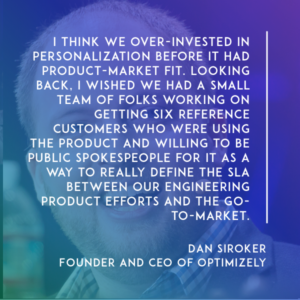
The second thing is I think we over invested early on in personalization before it had product-market fit. Looking back, what I wished I had done differently is have a small team of folks working on getting six reference customers who are using the product, paying for the product, and are willing to be public spokespeople for the product as a way to really define the SLA between our engineering product efforts and the go to market.
We had made that clear commitment to say, “Hey, the goal of engineering and product is to get six reference customers, and then we’re going to put the gas on with personalization.” That would have helped us. We wouldn’t have this large investment of people still trying to figure out due discovery why they’re delivering the product.
Ajay: But now it’s done.
Dan: I feel it’s great now, but it was a painful journey. Hopefully you don’t make the same mistake I did. I think it’s a reflection that it’s hard to build something great. It really is.
I’m really humbled and proud of the growth that we’ve had with testing, but as you alluded to, I think we’re only getting started. Testing and personalization are the first two steps we think of as a hundred year journey toward enabling the world to turn data into action.
It’s easy to lose sight of that journey when you see all these other companies that are growing quickly and you get, I think I’ll describe this. I’ve seen this here talking to some folks in the audience. I’ll describe this as the startup duck syndrome where everyone talks about, just like a pond of ducks. You see the ducks on the surface. They all look great, but underneath the water, they’re paddling really, really hard.
If you go around in the audience of, I talked to folks, people are all crushing it. They’re all doing great, but the truth is underneath the surface, you’re working really, really hard. I don’t want anyone to think that doing what you’re doing is going to be an overnight success.
Certainly, when you had some semblance of success, there’s always things you can be doing better. I know that for our company and I’m sure that’s true for many of yours. It’s the journey that I appreciate, but no, you’re not the only one struggling.
Ajay: You mentioned some of the lessons learned around personalization. Now that you’re six years into it, looking back, you’ve had tremendous success. Are the things that knowing what you know now that you would have done differently in 2009, 2010, decisions you wished you’d made in a different way.
Obviously, overall, it’s worked out great and you’ve built a phenomenal company, but anything that you think about that will be useful for the founders in the crowd?
Dan: One of the best pieces of advice I got along this journey, that I wish I knew earlier, was that the role of management is to make sure everyone understands what you understand. I look back at the decision to do personalization or even earlier, I had a very clear sense of having seen the whole company, all of the edges of the organization, a clear sense of what made sense and what didn’t.
But as you get to a certain size when you’re 200, 250 people, the vast majority of the decisions that matter for the company are happening in rooms that I’m not in, that my management team may not even be in.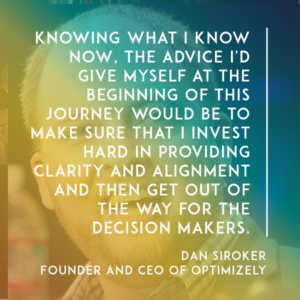
Providing clarity and alignment from day one, a clear sense of what’s important and what’s not, more importantly, the ability to get focused and in clear direction on success. What is the outcome for success look like? Not prescribe the how, don’t tell people how to do their job, but really describe what the outcome for success is and holding them accountable to the outcome for success, and let the people closest to the decision make the decisions on the how and how to get there.
That’s the advice I’d give myself, which is to make sure that I invest hard in providing clarity and alignment and then getting out of the way.
Ajay: Makes sense. Dan, last question for you. If you have 10 years to live, what would you do?
Dan: I’ll do exactly what I’m going right now, sitting here with all of you.
Ajay: Thank you so much, Dan.
Dan: Thank you.
